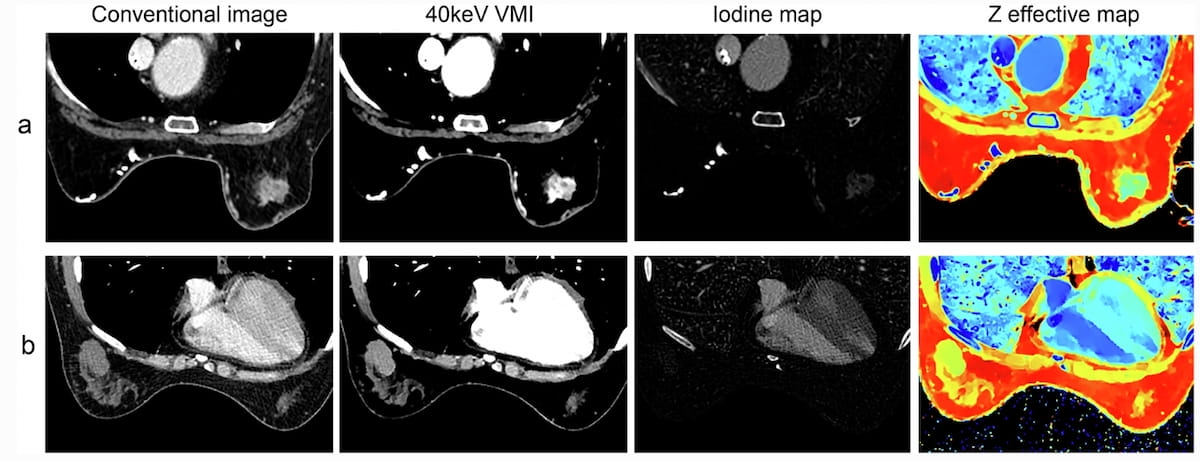New research suggests that a dual-energy computed tomography (DECT) model may provide benefit in differentiating breast lesions.
For the prospective study, recently published in Insights into Imaging, researchers evaluated the use of a model combining lesion shape, patient age and effective atomic number (Zeff) in the venous phase of DECT. The cohort was comprised of 200 patients (mean age of 49.9) with a total of 222 breast lesions (including 179 malignancies), according to the study. The study authors noted that the patients had ultrasound or mammography detection of BI-RADS 4A, 4B, 4C or 5 breast lesions but had no prior exposure to chemotherapy or radiotherapy of the breast.
In subsequent testing of the DECT-based model, the researchers noted a 79.1 percent area under the curve (AUC), and an 86.8 percent sensitivity in differentiating between malignant and benign breast lesions.
Model testing also revealed higher attenuation levels for malignant lesions in comparison to benign lesions across conventional imaging (87.6 HU vs. 70.2 HU in the venous phase) and 40-keV virtual monoenergetic imaging (VMI)(70.4 HU vs. 55.8 HU in the arterial phase). They also noted higher measures for malignant lesions with other DECT-based parameters such as iodine mapping (1.66 vs. 1.23 in the venous phase) and Zeff (7.45 vs. 7.33 in the arterial phase).
“This might imply that malignant breast lesions have more potential microvessels and angiogenesis, as these DECT quantitative parameters correlate to the distribution and content of contrast agents in lesions,” noted lead study author Han Xia, M.D., who is associated with the Department of Radiology at the Fudan University Shanghai Cancer Center and the Department of Oncology at Shanghai Medical College at Fudan University in Shanghai, China, and colleagues.
The researchers found that differentiation between malignant and benign lesions for DECT parameters were more pronounced in the venous phase as opposed to the arterial phase. For example, the study authors noted over a 26 percent higher sensitivity rate with 40-keV VMI attenuation in the venous phase (97.6 percent) in contrast to the arterial phase (71.4 percent). The study authors also noted a 1.66 mg/mL iodine concentration (IC) for malignant lesions in contrast to 1.23 mg/mL for benign breast lesions in the venous phase in comparison to an 0.33/0.16 mg/mL difference in the arterial phase.
“A possible explanation was that the DECT protocol applied in this study was based on a chest-enhanced CT protocol, which might not have allowed the contrast agent to adequately penetrate breast lesions in the arterial phase, making venous phase scans more informative for the assessment of underlying microvessels within the lesions,” posited Xia and colleagues.
Three Key Takeaways
1. High sensitivity in differentiating breast lesions. The DECT-based model showed high sensitivity (86.8 percent) in differentiating between malignant and benign breast lesions, with an area under the curve (AUC) of 79.1 percent, indicating its potential effectiveness in clinical settings.
2. Distinct imaging features for malignancy. Malignant breast lesions demonstrated higher attenuation levels and iodine concentrations in DECT parameters compared to benign lesions, particularly in the venous phase.
3. Improved diagnostic information in venous phase. The study found that differences with DECT parameters were more pronounced in the venous phase than in the arterial phase, with a 26% higher sensitivity rate for 40-keV VMI attenuation in the venous phase. This suggests that venous phase imaging provides more informative data for the DECT model in assessing breast lesions.
While acknowledging that further research is needed and that CT does not represent conventional imaging for possible breast cancer, the study authors suggested the DECT model could have an impact in assessing subsequent workup needs for detected breast tumors.
“ … (DECT) might be helpful in characterizing multifocal or multicentric breast lesions during the systemic staging of breast cancers, potentially reducing the need for MRI,” suggested Xia and colleagues.
(Editor’s note: For related content, see “SNMMI: New Study Suggests Merits of FAPI PET/CT for Breast Cancer Imaging,” “PET/CT Shows Superior Results for Detecting Oligometastatic Breast Cancer in Comparison to CT” and “Current Perspectives on PET/CT Imaging in Patients with Metastatic Breast Cancer.”)
Beyond the inherent limitations of a single-center study, the researchers acknowledged possible bias with malignant lesions comprising 81 percent of the dataset. They also noted that consensus decisions on morphological feature analysis in the study may not have reflected a variety of experience levels. The study authors also conceded that they did not assess the model’s capability for assessing different types of breast cancer.
